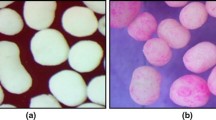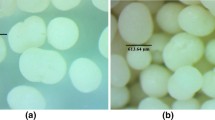ABSTRACT
Purpose
To elucidate the mass transport mechanisms controlling drug release from recently proposed, ethanol-resistant, polymeric film coatings.
Methods
Theophylline matrix pellets were coated with ethylcellulose: guar gum blends. Drug release from single pellets and ensembles of pellets was measured in various release media. Changes in the systems’ morphology, composition and mechanical properties were monitored using SEM, gravimetrical analysis and a texture analyzer. Based on the obtained experimental results a mechanistically realistic mathematical model was identified and used to quantitatively predict drug release from coated pellets in ethanol-free and ethanol-containing bulk fluids.
Results
Drug diffusion though the intact polymeric film coatings is likely to be the dominant mass transport mechanism in the investigated systems, irrespective of the ethanol content in the surrounding environment. An appropriate solution of Fick’s law could be used to quantitatively predict theophylline release from pellets coated with different ethylcellulose:guar gum blends at different coating levels. Importantly, independent experiments confirmed the theoretical predictions.
Conclusions
In silico simulations can help facilitating the optimization of the novel ethanol-resistant polymeric film coatings, avoiding time-consuming and cost-intensive series of trial-and-error experiments. The presence/absence of ethanol does not affect the underlying drug release mechanisms.









Similar content being viewed by others
REFERENCES
Rosiaux Y, Muschert S, Chokshi R, Leclercq B, Siepmann F, Siepmann J. Ethanol-resistant polymeric film coatings for controlled drug delivery. J Control Release. 2013;169:1–9.
Fadda HM, Mohamed MAM, Basit AW. Impairment of the in vitro release behaviour of oral modified release preparations in the presence of alcohol. Int J Pharm. 2008;360:171–6.
HMP1013. A randomised, open-label, single dose, 4 way crossover study of the effects of varying doses of ethanol on the pharmacokinetic characteristics of 12 mg hydromorphone hydrochloride extended release capsules (Palladone™) in two groups (fed and fasted) of healthy volunteers. Data in house, Purdue Pharma (US).
Walden M, Nicholls FA, Smith KJ. The effect of ethanol on the release of opioids from oral prolonged-release preparations. Drug Dev Ind Pharm. 2007;33:1101–11.
Roberts M, Cespi M, Ford JL, Dyas AM, Downing J, Martini LG, et al. Influence of ethanol on aspirin release from hypromellose matrices. Int J Pharm. 2007;332:31–7.
Traynor MJ, Brown MB, Pannala A, Beck P, Maetin GP. Influence of alcohol on the release of tramadol from 24-h controlled-release formulations during in vitro dissolution experiments. Drug Dev Ind Pharm. 2008;34:885–9.
Roth W, Setnik B, Zietsch M, Burst A, Breitenbach J, Sellers E, et al. Ethanol effects on drug release from Verapamil Meltrex, an innovative melt extruded formulation. Int J Pharm. 2009;368:72–5.
Lennernaes H. Ethanol-drug absorption interaction: potential for a significant effect on the plasma pharmacokinetics of ethanol vulnerable formulations. Mol Pharm. 2009;6:1429–40.
Larsson M, Hjaertstam J, Berndtsson J, Stading M, Larsson A. Effect of ethanol on the water permeability of controlled release films composed of ethyl cellulose and hydroxypropyl cellulose. Eur J Pharm Biopharm. 2010;76:428–32.
Smith AP, Moore TW, Westenberger BJ, Doub WH. In vitro dissolution of oral modified-release tablets and capsules in ethanolic media. Int J Pharm. 2010;398:93–6.
Booker EA, Haig AJ, Geisser ME, Yamakawa K. Alcohol use self report in chronic back pain—relationships to psychosocial factors, function performance, and medication use. Disabil Rehabil. 2003;25:1271–7.
Serdula MK, Brewer RD, Gillespie C, Denny CH, Mokdad A. Trends in alcohol use and binge drinking, 1985–1999 results of a multi-state survey. Am J Prev Med. 2004;26:294–8.
Lecomte F, Siepmann J, Walther M, MacRae RJ, Bodmeier R. pH-sensitive polymer blends used as coating materials to control drug release from spherical beads: elucidation of the underlying mass transport mechanisms. Pharm Res. 2005;22:1129–41.
Lecomte F, Siepmann J, Walther M, MacRae RJ, Bodmeier R. pH-sensitive polymer blends used as coating materials to control drug release from spherical beads: importance of the type of core. Biomacromolecules. 2005;6:2074–83.
Siepmann F, Siepmann J, Walther M, MacRae RJ, Bodmeier R. Blends of aqueous polymer dispersions used for pellet coating: importance of the particle size. J Control Release. 2005;105:226–39.
Siepmann J, Siepmann F, Florence AT. Local controlled drug delivery to the brain: mathematical modeling of the underlying mass transport mechanisms. Int J Pharm. 2006;314:101–19.
Marucci M, Ragnarsson G, Nilsson B, Axelsson A. Osmotic pumping release from ethyl–hydroxypropyl–cellulose-coated pellets: a new mechanistic model. J Control Release. 2010;142:53–60.
Kaunisto E, Marucci M, Borgquist P, Axelsson A. Mechanistic modelling of drug release from polymer-coated and swelling and dissolving polymer matrix systems. Int J Pharm. 2011;418:54–77.
Marucci M, Ragnarsson G, von Corswant C, Welinder A, Jarke A, Iselau F, et al. Polymer leaching from film coating: effects on the coating transport properties. Int J Pharm. 2011;411:43–8.
Muschert S, Siepmann F, Leclercq B, Carlin B, Siepmann J. Drug release mechanisms from ethylcellulose:PVA-PEG graft copolymer coated pellets. Eur J Pharm Biopharm. 2009;72:130–7.
Muschert S, Siepmann F, Leclercq B, Carlin B, Siepmann J. Prediction of drug release from ethylcellulose coated pellets. J Control Release. 2009;135:71–9.
Siepmann J, Siepmann F. Mathematical modeling of drug dissolution. Int J Pharm. 2013;453:12–24.
Siepmann J, Peppas NA. Modeling of drug release from delivery systems based on hydroxypropyl methylcellulose (HPMC). Adv Drug Del Rev. 2001;48:139–57.
Siepmann J, Goepferich A. Mathematical modeling of bioerodible, polymeric drug delivery systems. Adv Drug Del Rev. 2001;48:229–47.
Borgquist P, Nevsten P, Nilsson B, Wallenberg LR, Axelsson A. Simulation of the release from a multiparticulate system validated by single pellet and dose release experiments. J Control Release. 2004;97:453–65.
Marucci M, Ragnarsson G, Nyman U, Axelsson A. Mechanistic model for drug release during the lag phase from pellets coated with a semi-permeable membrane. J Control Release. 2008;127:31–40.
Lecomte F, Siepmann J, Walther M, MacRae RJ, Bodmeier R. Blends of enteric and GIT-insoluble polymers used for film coating: physicochemical characterization and drug release patterns. J Control Release. 2003;89:457–71.
Borgquist P, Zackrisson G, Nilsson B, Axelsson A. Simulation and parametric study of a film-coated controlled-release pharmaceutical. J Control Release. 2002;80:229–45.
Ho L, Cuppok Y, Muschert S, Gordon KC, Pepper M, Shen Y, et al. Effects of film coating thickness and drug layer uniformity on in-vitro drug release from sustained-release coated pellets: a case study using terahertz pulsed imaging. Int J Pharm. 2009;382:151–9.
Maroni A, Zema L, Loreti G, Palugan L, Gazzaniga A. Film coatings for oral pulsatile release. Int J Pharm. 2013. doi:10.1016/j.ijpharm.2013.03.010.
Siepmann J, Siepmann F. Mathematical modeling of drug delivery. Int J Pharm. 2008;364:328–43.
Lecomte F, Siepmann J, Walther M, MacRae RJ, Bodmeier R. Polymer blends used for the coating of multiparticulates: comparison of aqueous and organic coating techniques. Pharm Res. 2004;21:882–90.
Lecomte F, Siepmann J, Walther M, MacRae RJ, Bodmeier R. Polymer blends used for the aqueous coating of solid dosage forms: importance of the type of plasticizer. J Control Release. 2004;99:1–13.
Crank J. The mathematics of diffusion. Oxford: Clarendon; 1975.
Siepmann J, Siepmann F. Modeling of diffusion controlled drug delivery. J Control Release. 2012;161:351–62.
Acknowledgments And Disclosures
Two of the authors are employees of FMC BioPolymer, the company commercializing Aquacoat® ECD 30.
Author information
Authors and Affiliations
Corresponding author
Rights and permissions
About this article
Cite this article
Rosiaux, Y., Velghe, C., Muschert, S. et al. Mechanisms Controlling Theophylline Release from Ethanol-Resistant Coated Pellets. Pharm Res 31, 731–741 (2014). https://doi.org/10.1007/s11095-013-1194-1
Received:
Accepted:
Published:
Issue Date:
DOI: https://doi.org/10.1007/s11095-013-1194-1




